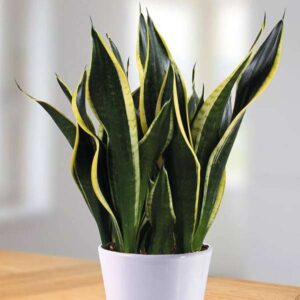15 Best Air Purifying Plants for Bedroom: Breathe Fresh and Sleep Better
Introduction
Indoor air pollution is a silent health threat that most of us overlook. From furniture to cleaning products, everyday items in our bedrooms release harmful toxins such as formaldehyde, benzene, and xylene. Thankfully, nature offers a solution — air-purifying plants.
According to NASA’s Clean Air Study, certain houseplants not only absorb carbon dioxide but also eliminate toxins from the air. Adding them to your bedroom can lead to better sleep, reduced stress, and a healthier home environment.
In this article, we’ll explore the 15 best air-purifying plants for bedrooms, with their benefits and care instructions.
1. Snake Plant (Sansevieria trifasciata)
🧪 Purifies:
Formaldehyde, benzene, xylene, toluene
🌡️ Care:
Low light, little water, tolerant of neglect
Also called Mother-in-Law’s Tongue, this is one of the only plants that releases oxygen at night, making it ideal for bedrooms.

2. Peace Lily (Spathiphyllum)
🧪 Purifies:
Benzene, formaldehyde, trichloroethylene
🌡️ Care:
Low to moderate light, keep soil moist
Peace Lilies are elegant, flowering plants that increase humidity and remove air toxins efficiently. They’re perfect for corners with indirect light.
3. Spider Plant (Chlorophytum comosum)
🧪 Purifies:
Carbon monoxide, benzene, xylene
🌡️ Care:
Bright, indirect light; water weekly
This beginner-friendly plant is pet-safe, fast-growing, and produces “babies” that you can repot. It’s also effective at absorbing allergens.

4. Aloe Vera
🧪 Purifies:
Formaldehyde, benzene
🌡️ Care:
Bright light, water only when dry
Besides its skin benefits, aloe vera purifies indoor air and releases oxygen at night, making it excellent for bedroom air.
5. Areca Palm (Dypsis lutescens)
🧪 Purifies:
Formaldehyde, benzene, carbon monoxide
🌡️ Care:
Bright, indirect light; high humidity
Also known as the Butterfly Palm, this elegant plant works as a natural humidifier and air freshener.
6. Pothos (Epipremnum aureum)
🧪 Purifies:
Formaldehyde, benzene
🌡️ Care:
Low light, water when dry
Popularly called Money Plant, Pothos is a hardy trailing plant that survives in low-light bedrooms and is easy to grow.
7. Rubber Plant (Ficus elastica)
🧪 Purifies:
Formaldehyde
🌡️ Care:
Bright, indirect light; water weekly
This attractive plant with thick, glossy leaves is a strong toxin eliminator and adds a modern aesthetic to your bedroom.

8. English Ivy (Hedera helix)
🧪 Purifies:
Mold spores, benzene
🌡️ Care:
Cool, moderate light; moist soil
It’s ideal for allergy sufferers, as English Ivy helps reduce airborne mold. Hang it in a basket or let it trail on a shelf.
9. Boston Fern (Nephrolepis exaltata)
🧪 Purifies:
Formaldehyde, xylene
🌡️ Care:
Indirect light, regular misting
Boston Ferns are beautiful air humidifiers. Their feathery fronds add a cozy, soft texture to any bedroom corner.
10. Chinese Evergreen (Aglaonema)
🧪 Purifies:
Benzene, formaldehyde
🌡️ Care:
Low light, water every 5–10 days
This colorful foliage plant is low-maintenance and ideal for dim bedrooms or office setups.
11. ZZ Plant (Zamioculcas zamiifolia)
🧪 Purifies:
Toluene, xylene
🌡️ Care:
Low light, drought-tolerant
With its shiny green leaves and air-purifying ability, ZZ Plant thrives in dark corners with very little care.

12. Dracaena Marginata (Dragon Tree)
🧪 Purifies:
Xylene, trichloroethylene
🌡️ Care:
Bright, filtered light; water weekly
A tall, dramatic indoor plant with narrow red-edged leaves that filters air and fits beautifully in bedroom corners.
13. Anthurium (Flamingo Flower)
🧪 Purifies:
Ammonia, formaldehyde
🌡️ Care:
Medium light, moist soil
This flowering beauty adds color and improves air quality. Ideal if you want visual appeal plus cleaner air.
14. Gerbera Daisy (Gerbera jamesonii)
🧪 Purifies:
Benzene, trichloroethylene
🌡️ Care:
Bright sunlight, consistent watering
Unlike most flowers, this plant also acts as an air filter and releases oxygen at night, helping you sleep better.

15. Fiddle Leaf Fig (Ficus lyrata)
🧪 Purifies:
Formaldehyde, benzene
🌡️ Care:
Bright light, moderate watering
With its big, dramatic leaves, Fiddle Leaf Fig adds personality while improving air quality in large bedrooms.
READ ALSO: Top 15 Fast Growing Indoor Plants for Home Decor
Why Keep Plants in the Bedroom?
- Cleaner air = better sleep
- Increased humidity = healthy skin and breathing
- Natural stress relief
- Visual calm and aesthetic decor
- Some plants (like snake plant, aloe vera) even release oxygen at night
Tips for Success
- Keep leaves dust-free
- Don’t overwater
- Ensure the plant matches your light conditions
- Repot when root-bound
- Check if the plant is pet-safe (especially if you have cats or dogs)
Frequently Asked Questions (FAQs)
Which plant is best for bedroom air purification?
Snake Plant and Peace Lily are among the best for bedroom air purification. Snake Plant releases oxygen at night, making it ideal for sleep.
Can I keep plants in my bedroom at night?
Yes! Many indoor plants, like Aloe Vera and Snake Plant, release oxygen at night and help clean the air — promoting better sleep.
Do air-purifying plants really work?
Yes, according to NASA’s Clean Air Study, certain indoor plants can absorb toxins like formaldehyde, benzene, and xylene, improving air quality.
How many plants should I keep in the bedroom?
NASA recommends keeping 2–3 medium-sized plants per 100 square feet of space for optimal air purification benefits.
Are these plants safe for pets?
Some air-purifying plants, like Spider Plant and Areca Palm, are pet-safe. Others, like Peace Lily and Pothos, are toxic to pets if ingested. Always check plant safety if you have cats or dogs.
Do these plants need sunlight?
Most air-purifying plants prefer bright, indirect light, but several (like ZZ Plant and Snake Plant) can tolerate low-light conditions, making them suitable for bedrooms.
How often should I water bedroom plants?
It depends on the plant:
- Snake Plant, ZZ Plant: Once every 2–3 weeks
- Peace Lily, Spider Plant: Once a week
- Boston Fern: Needs regular misting
Always check the soil before watering.
Conclusion
Your bedroom should be your sanctuary — a place to rest, recharge, and breathe easy. By incorporating these 15 air-purifying plants, you’re not only improving your health but also enhancing your home’s beauty and making your home beautiful.
Start small — even one plant can make a difference

